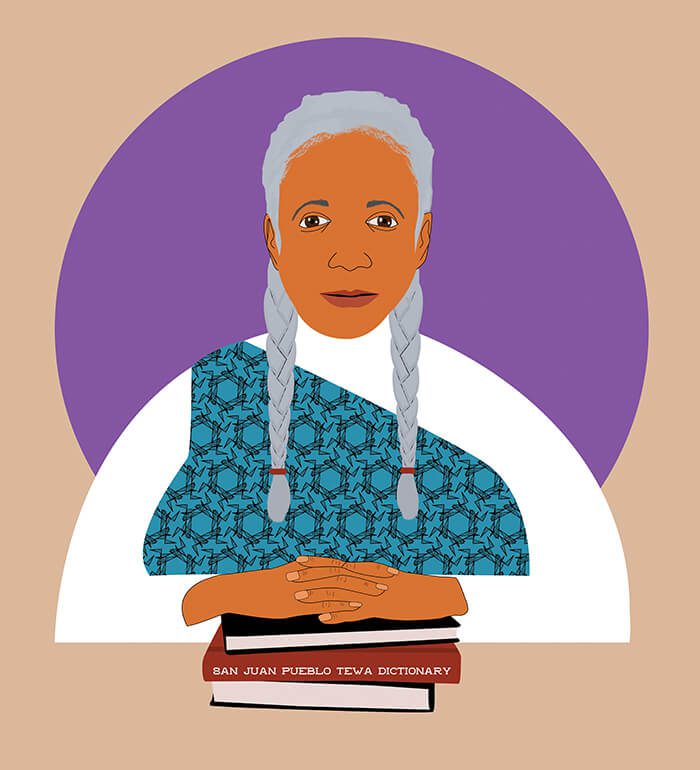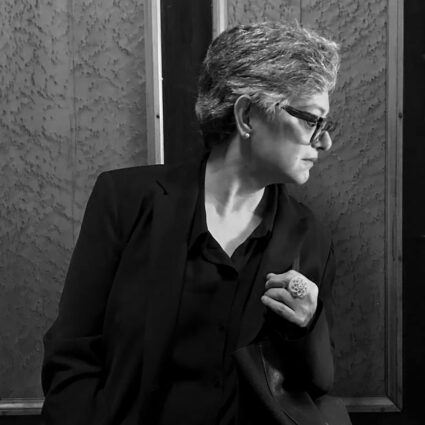
Name: P’oe Tsáwä (Blue Water), also Esther Martinez
Born: Ignacio, Colorado, 1912
Died: Española, New Mexico, 2006
Role: Storyteller
Known for: Writing the San Juan Pueblo Tewa Dictionary
“I was born in 1912, the year the Titanic sank and the year New Mexico became a state,” P’oe Tsáwä, or Blue Water, begins her memoir. Known by Anglos as Esther Martinez, P’oe Tsáwä lived through periods of unimaginable change. As a child, she recalls riding in a covered wagon with her grandparents from Ute Colorado to San Juan Pueblo (Ohkay Owinge), where she lived with them. Her grandfather only let the horses walk, no trotting or running, so the journey was purposefully slow and took several days. “In those times,” she recalls, “there were no motels. … There were no hot dog stands.” They cooked breakfast, lunch, and dinner over a fire by the side of the road. She lived through so many different worlds: from wagons to airplanes, from being punished for speaking her native language in school to being recognized by the NEA for recording it.
While she is often thought of as the woman who “saved” the Tewa language, she envisioned her role not as a cultural preserver but as a mediator. “Ours is not a lost culture,” P’oe Tsáwä insisted. Though the names of Tewa places and people were changed by the Spanish conquistadors (“that is where the Martinez came from”), and English is now spoken in homes on the pueblo due to intermarriages from other tribes and non-Natives, Tewa persists. In her stories and recollections, told aloud, recorded, transcribed, and collected in My Life in San Juan Pueblo, P’oe Tsáwä conjures a world in which children are cared for by the entire community, and everyone respects and cares for elders. She writes with passionate detail about the work they did and still do together, washing wheat, grinding corn, pressing down the earthen floors of their homes.
At fifty-four, she began taking classes in Tewa language at the University of North Dakota and at St. John’s College, and soon began to teach the language in schools in San Juan Pueblo from 1974-1989
After living with her grandparents on San Juan Pueblo, a U.S. government program sent P’oe Tsáwä to boarding school, first at the Santa Fe Indian School and then the Albuquerque Indian School, from which she graduated in 1930. In boarding school, she was not allowed to speak Tewa. After school, P’oe Tsáwä had ten children, whom she supported by cooking and cleaning in the early days at Los Alamos. At fifty-four, she began taking classes in Tewa language at the University of North Dakota and at St. John’s College, and soon began to teach the language in schools in San Juan Pueblo from 1974-1989. She became the director of bilingual education at San Juan Pueblo day school. During this same period, P’oe Tsáwä created the first Tewa dictionary, recording the language so that it might continue to be taught and used. She also translated the New Testament into Tewa. Beyond her work as a teacher, linguist, and translator, P’oe Tsáwä devoted her life to telling stories in Tewa and in English as a way to share the culture and values with which she was raised. In 1988, she began traveling with Storytelling International, speaking all over the country to Native and non-Native audiences. She was also a National Park Service storyteller.
In 2006, P’oe Tsáwä was named by the NEA as a National Heritage Fellow, the highest honor for folk artists. In Washington, DC, at the Great Hall of the Library of Congress, P’oe Tsáwä was called a “national treasure” and received a standing ovation for her work. Soon after the event, P’oe Tsáwä was killed near Española, NM, by a drunk driver. Congress passed the Esther Martinez Act in her name in December 2006, which “provides for the revitalization of Native American languages through Native language immersion and restoration programs.”



